Rooftop garden projects in major cities like New York City showcase innovative approaches to utilizing urban spaces, fostering sustainability and community involvement. These green initiatives not only enhance air quality and biodiversity but also serve multiple functions, from food production to recreational areas, ultimately contributing to healthier urban ecosystems.

What are successful rooftop garden projects in New York City?
Successful rooftop garden projects in New York City demonstrate innovative uses of urban space, contributing to sustainability and community engagement. These projects often involve local partnerships and can serve various purposes, from food production to recreational areas.
Brooklyn Grange’s Urban Farm
Brooklyn Grange operates one of the largest rooftop soil farms in the world, located on two rooftops in Brooklyn and Queens. This urban farm grows a variety of organic vegetables and herbs, supplying local restaurants and community-supported agriculture (CSA) programs.
Key considerations for similar projects include selecting appropriate crops for rooftop conditions, ensuring structural integrity for weight loads, and implementing effective irrigation systems. Brooklyn Grange also emphasizes community involvement through workshops and volunteer opportunities, fostering a connection between urban residents and local agriculture.
Green Roof at the Javits Center
The Green Roof at the Javits Center is a notable example of integrating sustainability into large-scale architecture. Covering approximately 6.75 acres, this green roof features native plant species that help manage stormwater and improve air quality.
When planning a green roof project, factors such as plant selection, maintenance requirements, and potential energy savings should be evaluated. The Javits Center’s green roof not only enhances biodiversity but also serves as a habitat for local wildlife, showcasing the ecological benefits of urban greening initiatives.
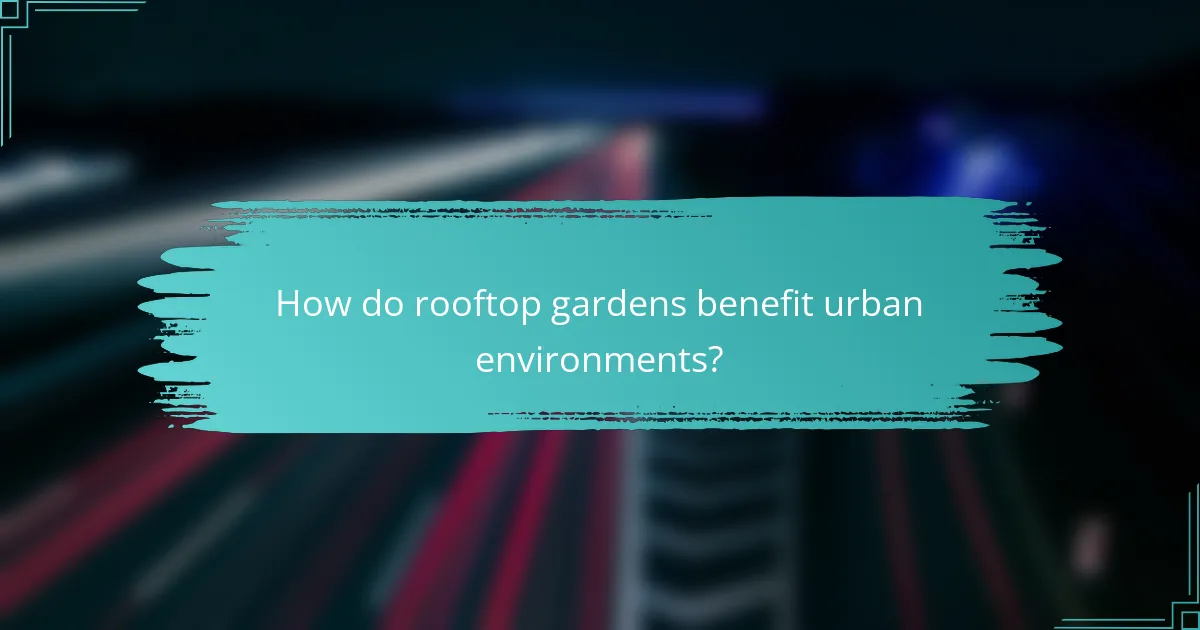
How do rooftop gardens benefit urban environments?
Rooftop gardens provide numerous advantages to urban settings, including improved air quality and enhanced biodiversity. These green spaces help mitigate pollution, reduce heat, and create habitats for various species, contributing to healthier city ecosystems.
Improved air quality
Rooftop gardens play a significant role in enhancing air quality by filtering pollutants and absorbing carbon dioxide. Plants in these gardens can reduce particulate matter and other harmful substances, leading to cleaner air for city dwellers.
In urban areas, where air pollution levels can be high, incorporating green roofs can lower temperatures and decrease the urban heat island effect. This cooling effect can help reduce energy consumption for air conditioning, further benefiting the environment.
Enhanced biodiversity
Rooftop gardens create new habitats for various plant and animal species, promoting biodiversity in densely populated areas. By introducing native plants, these gardens can attract pollinators like bees and butterflies, which are essential for ecosystem health.
Moreover, rooftop gardens can serve as stepping stones for wildlife, connecting fragmented habitats in urban landscapes. This connectivity is crucial for species survival and can contribute to the overall ecological resilience of cities.
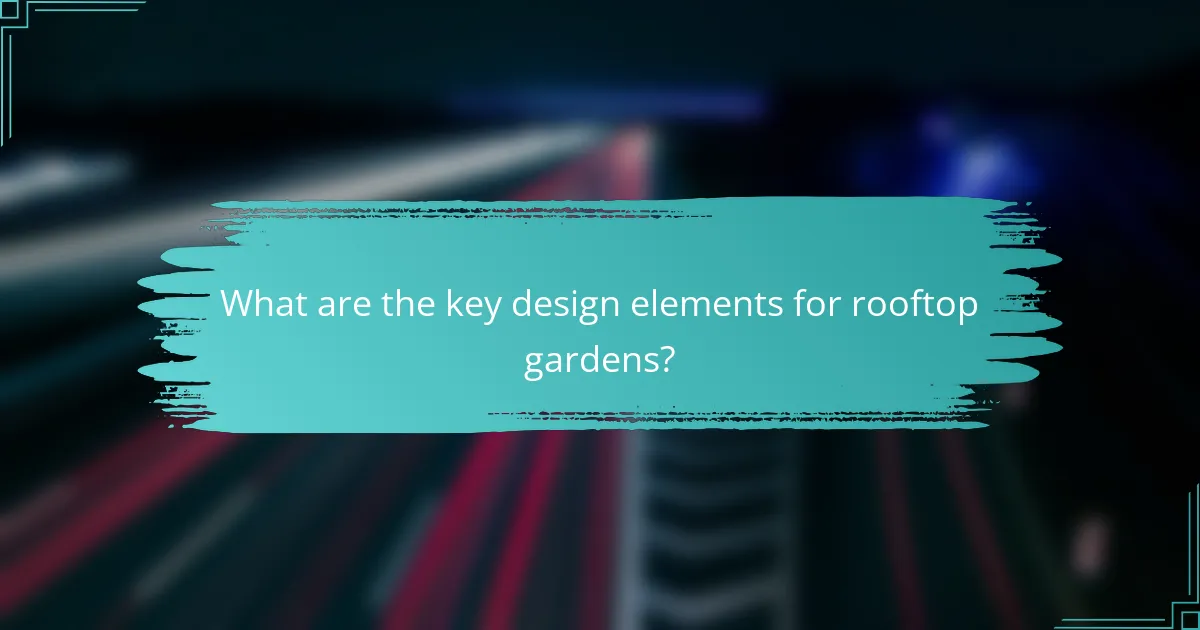
What are the key design elements for rooftop gardens?
Key design elements for rooftop gardens include plant selection, layout, and effective water management systems. These components are crucial for ensuring the garden thrives in an urban environment while maximizing space and resources.
Plant selection and layout
Choosing the right plants is essential for a successful rooftop garden. Opt for species that are well-suited to the local climate, such as drought-resistant plants in arid regions or native species that require less maintenance. Consider a mix of perennials and annuals to ensure year-round interest.
The layout should maximize sunlight exposure and accessibility. Group plants with similar water and light needs together to simplify care. Raised beds or containers can help define areas and improve drainage, while vertical gardens can save space and add visual appeal.
Water management systems
Effective water management is critical for rooftop gardens, as they are often exposed to wind and sun, which can dry out soil quickly. Implementing a drip irrigation system can provide consistent moisture while conserving water. Rainwater harvesting systems can also be beneficial, allowing you to collect and reuse rainwater for irrigation.
Consider using moisture sensors to monitor soil conditions and automate watering schedules. This not only saves water but also ensures plants receive adequate hydration. Regularly check for drainage issues to prevent water pooling, which can damage plants and the rooftop structure.

What are the costs associated with rooftop garden projects?
The costs associated with rooftop garden projects can vary significantly based on factors like location, design complexity, and plant selection. Generally, these expenses can be categorized into initial setup costs and ongoing maintenance expenses.
Initial setup costs
Initial setup costs for rooftop gardens typically range from a few thousand to tens of thousands of dollars. Key factors influencing these costs include structural assessments, waterproofing, soil and plant selection, and installation labor. For instance, a simple garden may cost around $3,000 to $5,000, while more elaborate designs can exceed $20,000.
When planning your budget, consider potential permits and local regulations that may apply. In some cities, obtaining a permit for structural modifications or garden installations can add to the initial expenses.
Maintenance expenses
Maintenance expenses for rooftop gardens can vary widely, generally falling between $500 and $2,000 annually. Regular tasks include watering, fertilizing, pruning, and pest management, which can require professional help or dedicated time from the property owner.
To keep costs manageable, consider implementing a self-sustaining garden design that minimizes water and fertilizer needs. Additionally, establishing a maintenance schedule can help prevent larger issues that may lead to increased costs down the line.
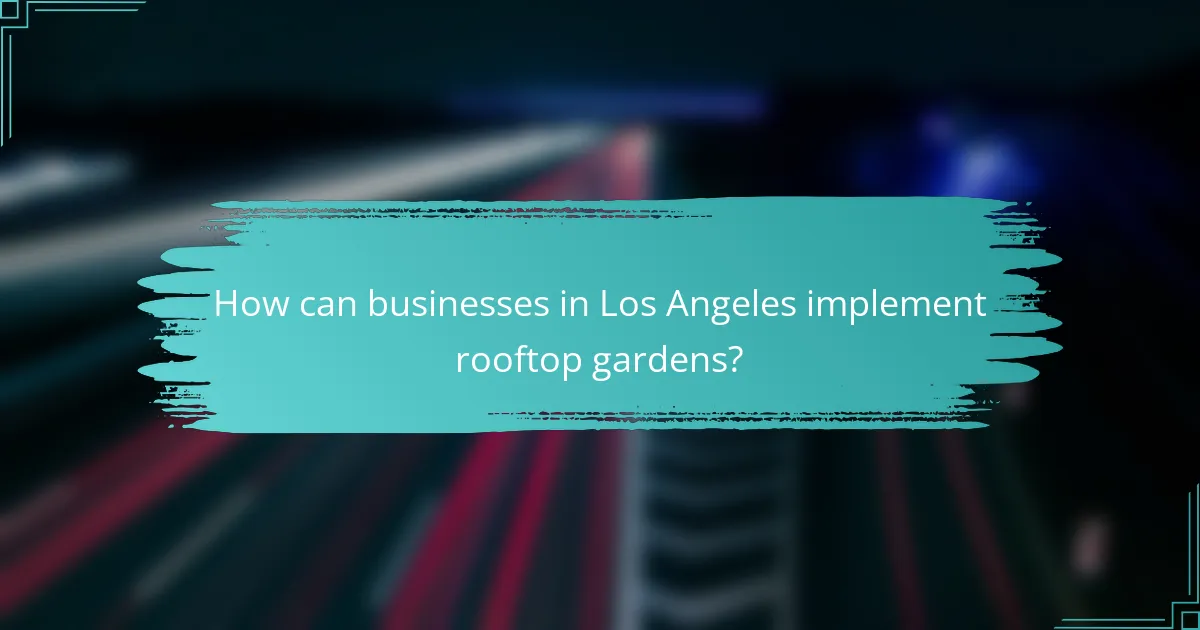
How can businesses in Los Angeles implement rooftop gardens?
Businesses in Los Angeles can implement rooftop gardens by leveraging local resources, engaging with community partners, and adhering to sustainable practices. These gardens not only enhance aesthetics but also contribute to environmental benefits and potentially lower energy costs.
Partnerships with local nurseries
Forming partnerships with local nurseries is essential for sourcing native plants that thrive in Los Angeles’ climate. Nurseries can provide valuable insights on plant selection, maintenance, and seasonal care, ensuring the rooftop garden remains vibrant and sustainable.
Consider reaching out to nurseries that specialize in drought-resistant plants, as these will require less water and maintenance. Collaborating with local experts can also help in organizing workshops for employees, fostering a sense of community and engagement with the garden.
Utilizing sustainable materials
When constructing rooftop gardens, using sustainable materials is crucial for minimizing environmental impact. Opt for recycled or reclaimed materials for planters, decking, and other structures to reduce waste and promote eco-friendliness.
Additionally, consider using lightweight soil alternatives to decrease the load on the building’s structure. Materials such as coconut coir or expanded clay aggregates can provide excellent drainage while being easier on the environment. Always check local building codes to ensure compliance with safety regulations when implementing these materials.
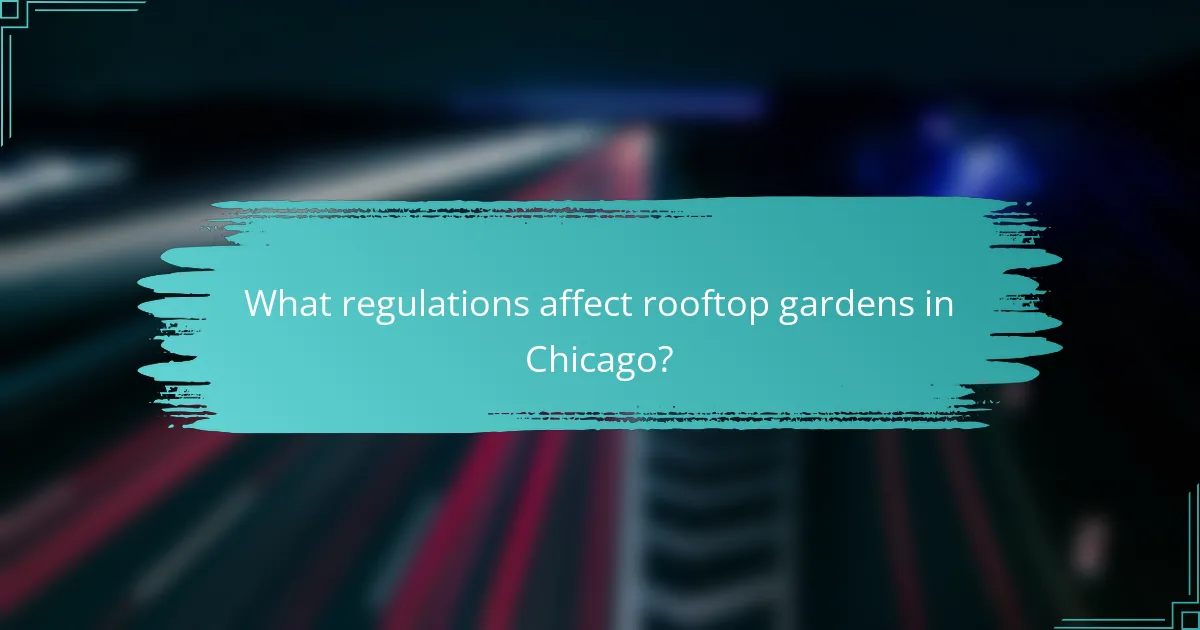
What regulations affect rooftop gardens in Chicago?
Rooftop gardens in Chicago are subject to various regulations that ensure safety, structural integrity, and environmental compliance. Key considerations include building codes, permits, and environmental assessments that must be adhered to for successful implementation.
Building codes and permits
In Chicago, rooftop gardens must comply with the city’s building codes, which dictate structural requirements and safety standards. Before starting a project, it’s essential to obtain the necessary permits, which may include zoning approvals and construction permits.
Typically, the process involves submitting detailed plans to the Department of Buildings, which reviews them for compliance. Engaging with a licensed architect or engineer can streamline this process and help avoid common pitfalls.
Environmental impact assessments
Environmental impact assessments (EIAs) are often required for rooftop garden projects, especially if they involve significant alterations to existing structures. These assessments evaluate potential effects on local ecosystems, water drainage, and urban heat islands.
In Chicago, the EIA process may include public hearings and consultations with environmental agencies. It’s advisable to conduct these assessments early in the planning phase to address any concerns and ensure compliance with local environmental regulations.
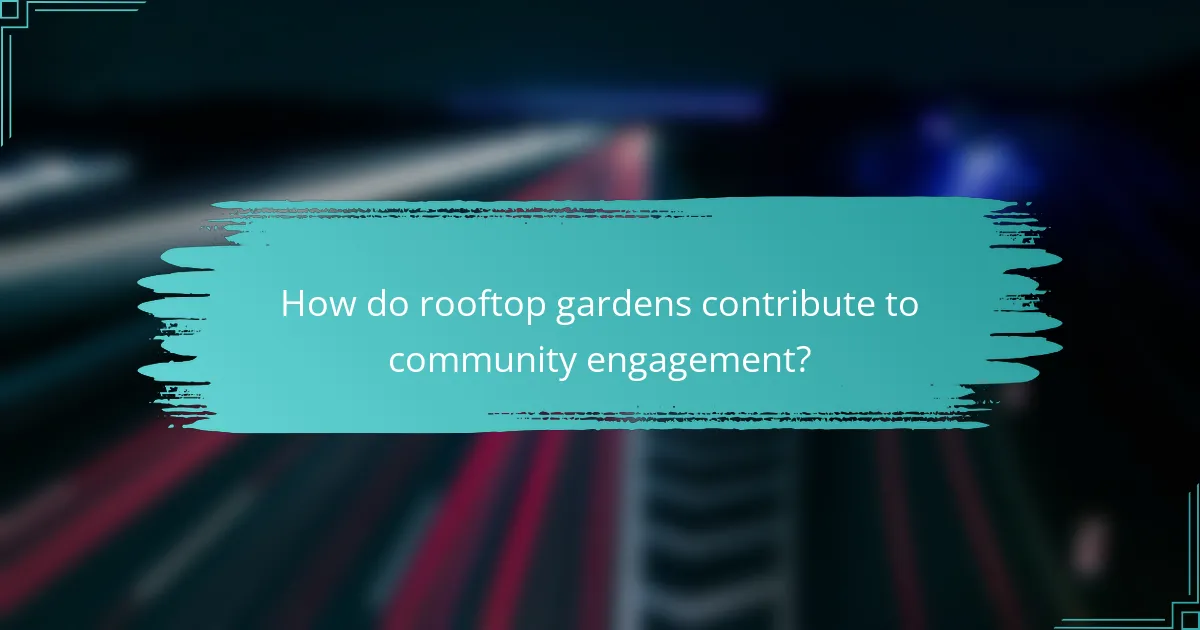
How do rooftop gardens contribute to community engagement?
Rooftop gardens enhance community engagement by providing shared spaces for residents to connect, learn, and collaborate. These green areas foster social interactions, promote environmental awareness, and encourage local participation in sustainable practices.
Educational workshops
Rooftop gardens serve as ideal venues for educational workshops that teach participants about gardening, sustainability, and nutrition. Local experts or community leaders can facilitate sessions on topics like organic gardening techniques, composting, and seasonal planting. These workshops often attract diverse groups, fostering a sense of community and shared learning.
Consider scheduling workshops during weekends or evenings to maximize attendance. Collaborating with local schools or community organizations can also enhance outreach and participation.
Community harvest events
Community harvest events allow residents to come together to collect produce from rooftop gardens, promoting a sense of ownership and pride in the shared space. These gatherings can be festive, featuring activities like cooking demonstrations, tastings, and recipe sharing, which further strengthen community bonds.
To organize a successful harvest event, plan for seasonal produce availability and consider partnering with local chefs or nutritionists to provide engaging content. Ensure that the event is accessible to all community members, potentially offering transportation or childcare services to encourage participation.
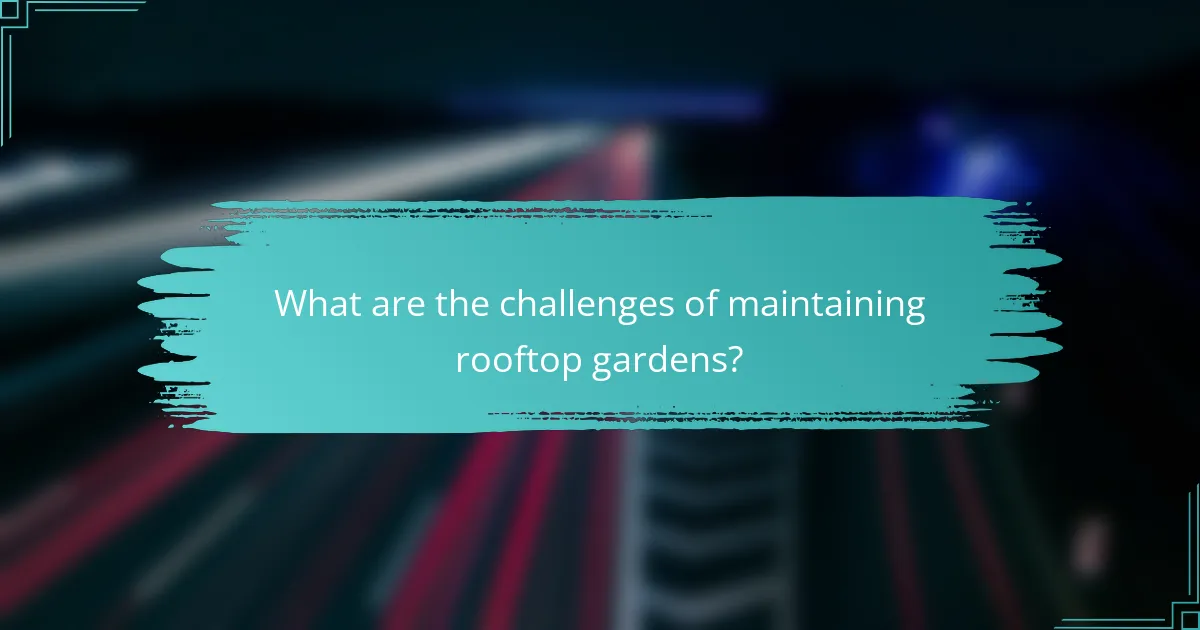
What are the challenges of maintaining rooftop gardens?
Maintaining rooftop gardens presents several challenges, including structural limitations, environmental factors, and ongoing care requirements. These issues can affect plant health and the overall success of the garden.
Structural limitations
Rooftop gardens must adhere to building codes and structural integrity requirements, which can limit the types of plants and materials used. Weighing the load-bearing capacity of the roof is crucial; typically, a rooftop can support around 15-20 pounds per square foot. This means careful selection of lightweight soil and plant species is essential.
Additionally, waterproofing and drainage systems must be properly installed to prevent leaks and water damage. Regular inspections are necessary to ensure these systems function effectively and to avoid costly repairs.
Environmental factors
Rooftop gardens are exposed to harsher environmental conditions than ground-level gardens, including wind, heat, and limited access to water. These factors can stress plants and require more frequent monitoring and care. For example, temperatures can be significantly higher on rooftops, necessitating the use of heat-tolerant plants.
Moreover, rooftop gardens may experience varying sunlight exposure depending on surrounding buildings. This variability can impact plant growth, making it important to select species that thrive in the specific light conditions of the rooftop.
Ongoing care requirements
Regular maintenance is vital for the health of rooftop gardens. This includes watering, weeding, pruning, and fertilizing, which can be more labor-intensive than traditional gardens. Establishing a consistent care schedule can help manage these tasks efficiently.
It’s also important to consider pest management, as rooftop gardens can attract various insects. Implementing integrated pest management strategies can help minimize issues while maintaining a healthy ecosystem.
